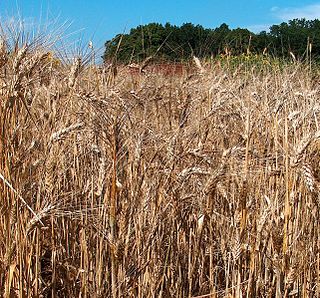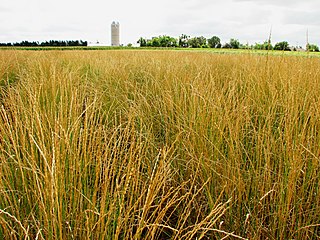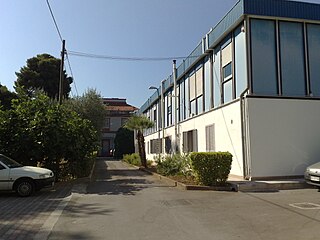Related Research Articles

Wheat is a grass widely cultivated for its seed, a cereal grain that is a staple food around the world. The many species of wheat together make up the genus Triticum ; the most widely grown is common wheat. The archaeological record suggests that wheat was first cultivated in the regions of the Fertile Crescent around 9600 BC. Botanically, the wheat kernel is a caryopsis, a type of fruit.

The oat, sometimes called the common oat, is a species of cereal grain grown for its seed, which is known by the same name. Oats appear to have been domesticated as a secondary crop, as their seeds resembled those of other cereals closely enough for them to be included by early cultivators. Oats tolerate cold winters less well than cereals such as wheat, barley, and rye, but need less summer heat and more rain, making them important in areas such as Northwest Europe that have cool wet summers. They can tolerate low-nutrient and acid soils. Oats grow thickly and vigorously, allowing them to outcompete many weeds, and compared to other cereals are relatively free from diseases.

Triticale is a hybrid of wheat (Triticum) and rye (Secale) first bred in laboratories during the late 19th century in Scotland and Germany. Commercially available triticale is almost always a second-generation hybrid, i.e., a cross between two kinds of primary (first-cross) triticales. As a rule, triticale combines the yield potential and grain quality of wheat with the disease and environmental tolerance of rye. Only recently has it been developed into a commercially viable crop. Depending on the cultivar, triticale can more or less resemble either of its parents. It is grown mostly for forage or fodder, although some triticale-based foods can be purchased at health food stores and can be found in some breakfast cereals.

Durum wheat, also called pasta wheat or macaroni wheat, is a tetraploid species of wheat. It is the second most cultivated species of wheat after common wheat, although it represents only 5% to 8% of global wheat production. It was developed by artificial selection of the domesticated emmer wheat strains formerly grown in Central Europe and the Near East around 7000 BC, which developed a naked, free-threshing form. Like emmer, durum wheat is awned. It is the predominant wheat that grows in the Middle East.

The John Innes Centre (JIC), located in Norwich, Norfolk, England, is an independent centre for research and training in plant and microbial science founded in 1910. It is a registered charity grant-aided by the Biotechnology and Biological Sciences Research Council (BBSRC), the European Research Council (ERC) and the Bill and Melinda Gates Foundation and is a member of the Norwich Research Park. In 2017, the John Innes Centre was awarded a gold Athena SWAN Charter award.

A landrace is a domesticated, locally adapted, often traditional variety of a species of animal or plant that has developed over time, through adaptation to its natural and cultural environment of agriculture and pastoralism, and due to isolation from other populations of the species. Landraces are distinct from cultivars and from standard breeds.

Khorasan wheat or Oriental wheat is a tetraploid wheat species. The grain is twice the size of modern-day wheat, and has a rich, nutty flavor.

Thinopyrum intermedium, known commonly as intermediate wheatgrass, is a sod-forming perennial grass in the Triticeae tribe of Pooideae native to Europe and Western Asia. It is part of a group of plants commonly called wheatgrasses because of the similarity of their seed heads or ears to common wheat. However, wheatgrasses generally are perennial, while wheat is an annual. It has gained the Royal Horticultural Society's Award of Garden Merit as an ornamental.
Crop diversity or crop biodiversity is the variety and variability of crops, plants used in agriculture, including their genetic and phenotypic characteristics. It is a subset of a specific element of agricultural biodiversity. Over the past 50 years, there has been a major decline in two components of crop diversity; genetic diversity within each crop and the number of species commonly grown.

Istituto di Genetica Vegetale (IGV) is a research network om Plant Genetics and Breeding within the Italian Consiglio Nazionale delle Ricerche. IGV is headquartered in Bari and has four different Divisions in Portici, Palermo, Florence and Perugia. IGV started its activities in November 2002.

Plant breeding is the science of changing the traits of plants in order to produce desired characteristics. It has been used to improve the quality of nutrition in products for humans and animals. The goals of plant breeding are to produce crop varieties that boast unique and superior traits for a variety of applications. The most frequently addressed agricultural traits are those related to biotic and abiotic stress tolerance, grain or biomass yield, end-use quality characteristics such as taste or the concentrations of specific biological molecules and ease of processing.
The U.S. National Plant Germplasm System (NPGS) is a network of institutions and agencies led by the Agricultural Research Service (ARS) of the U.S. Department of Agriculture in the effort to conserve and facilitate the use of the genetic diversity of agriculturally important plants and their wild relatives.
Plant breeding started with sedentary agriculture, particularly the domestication of the first agricultural plants, a practice which is estimated to date back 9,000 to 11,000 years. Initially, early human farmers selected food plants with particular desirable characteristics and used these as a seed source for subsequent generations, resulting in an accumulation of characteristics over time. In time however, experiments began with deliberate hybridization, the science and understanding of which was greatly enhanced by the work of Gregor Mendel. Mendel's work ultimately led to the new science of genetics. Modern plant breeding is applied genetics, but its scientific basis is broader, covering molecular biology, cytology, systematics, physiology, pathology, entomology, chemistry, and statistics (biometrics). It has also developed its own technology. Plant breeding efforts are divided into a number of different historical landmarks.
The Wheat Improvement Strategic Programme (WISP) is a Biotechnology and Biological Sciences Research Council (BBSRC) funded collaborative programme for wheat improvement, which brings together experts from five UK institutions: John Innes Centre, Rothamsted Research, the National Institute for Agricultural Botany (NIAB) and the University of Nottingham, and the University of Bristol. The programme is divided into four pillars and two themes.

Dilbagh Singh Athwal was an Indian-American geneticist, plant breeder and agriculturist, known to have conducted pioneering research in plant breeding. He was a professor and the Head of the Department of Plant Breeding at Punjab Agricultural University and an associate of Norman Borlaug, a renowned biologist and Nobel Laureate, with whom he has collaborated for the introduction of high-yielding dwarf varieties of wheat.
A composite cross population (CCP) is created by crossing a number of plants from different lines, and subsequently bulking seeds from the resulting offspring. This makes a CCP a population of plants with a lot of inherent genetic diversity, in contrast to monocultures where all plants are clones and homozygous at all loci. In recent years CCPs have been proposed as a way to create modern landraces of wheat, barley and oats. Research is done to explore whether they are better suited for organic farming than the modern cultivars.

Plant genetic resources describe the variability within plants that comes from human and natural selection over millennia. Their intrinsic value mainly concerns agricultural crops.
Ralph Merrill Caldwell was an American plant breeder, mycologist, and plant pathologist. Through his work with the U.S. Department of Agriculture and Purdue University, he developed disease-resistant cultivars for a wide variety of plants, including widely-grown wheat cultivars.
The A E Watkins Landrace Wheat Collection is a collection of heritage (landrace) varieties of wheat from around the world which are adapted to their local growing environment, the collection was collected in the 1930s and contains materials from 32 countries.
Arthur Ernest Watkins was an English botanist known for his foundational work in plant genetics.
References
- ↑ Historic grain collections helps preserve future biodiversity
- ↑ History of JIC
- ↑ Focus on Biodiversity
- ↑ Horler, R.; Turner, A.; Fretter, P.; Ambrose, M. (2017). "SeedStor: A Germplasm Information Management System and Public Database". Plant and Cell Physiology . 59 (1). Oxford University Press: e5. doi:10.1093/pcp/pcx195. ISSN 0032-0781. PMC 5914401 . PMID 29228298. S2CID 19049796.
- ↑ "SeedStor Homepage". Archived from the original on 19 January 2015. Retrieved 19 January 2015.
- ↑ "Germplasm Resource Unit (GRU)".
- ↑ Wingen, L. U.; Orford, S.; Goram, R.; Leverington-Waite, M.; Bilham, L.; Patsiou, T. S.; Ambrose, M.; Dicks, J.; Griffiths, S. (2014). "Establishing the A. E. Watkins landrace cultivar collection as a resource for systematic gene discovery in bread wheat". Theoretical and Applied Genetics . 127 (8): 1831–1842. doi:10.1007/s00122-014-2344-5. PMC 4110413 . PMID 24985064.
- ↑ BBSRC Cereals Collection https://www.jic.ac.uk/germplas/BBSRC_CE/Index.htm Archived 19 January 2015 at the Wayback Machine
- ↑ "Add a new plant variety to the national lists". GOV.UK. 5 April 2023. Retrieved 24 August 2023.
- ↑ "Germplasm Resources Unit (GRU)". John Innes Centre .